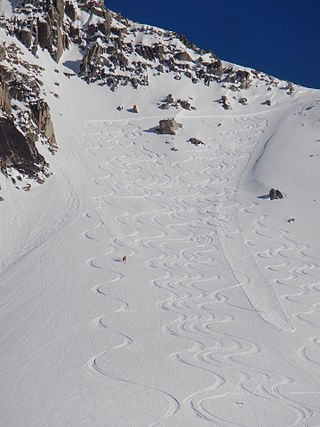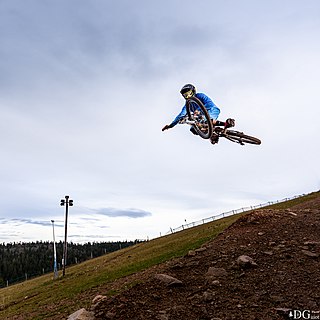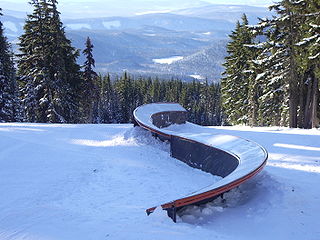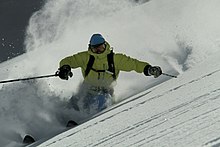
Snowboards are boards where the user places both feet, usually secured, to the same board. The board itself is wider than most skis, with the ability to glide on snow. Snowboards widths are between 6 and 12 inches or 15 to 30 centimeters. Snowboards are differentiated from monoskis by the stance of the user. In monoskiing, the user stands with feet inline with direction of travel, whereas in snowboarding, users stand with feet transverse to the longitude of the board. Users of such equipment may be referred to as snowboarders. Commercial snowboards generally require extra equipment such as bindings and special boots which help secure both feet of a snowboarder, who generally ride in an upright position. These types of boards are commonly used by people at ski hills, mountains, backcountry, or resorts for leisure, entertainment, and competitive purposes in the activity called snowboarding.

Skiing is the use of skis to glide on snow. Variations of purpose include basic transport, a recreational activity, or a competitive winter sport. Many types of competitive skiing events are recognized by the International Olympic Committee (IOC), and the International Ski and Snowboard Federation (FIS).

Snowboarding is a recreational and competitive activity that involves descending a snow-covered surface while standing on a snowboard that is almost always attached to a rider's feet. It features in the Winter Olympic Games and Winter Paralympic Games.
Freestyle skiing is a skiing discipline comprising aerials, moguls, cross, half-pipe, slopestyle and big air as part of the Winter Olympics. It can consist of a skier performing aerial flips and spins and can include skiers sliding rails and boxes on their skis. Known as "hot-dogging" in the early 1970s, it is also commonly referred to as freeskiing, jibbing, as well as many other names, around the world.

A terrain park or snow park is an outdoor recreation area containing terrain that allows skiers, snowboarders and snowbikers to perform tricks. Terrain parks have their roots in skateparks and many of the features are common to both.

Ski touring is skiing in the backcountry on unmarked or unpatrolled areas. Touring is typically done off-piste and outside of ski resorts, and may extend over a period of more than one day. It is similar to backcountry skiing but excludes the use of a ski lift or transport.

Backcountry skiing (US), also called off-piste (Europe), alpine touring, freeriding or out-of-area, is skiing in the backcountry on unmarked or unpatrolled areas either inside or outside a ski resort's boundaries. This contrasts with alpine skiing, which is typically done on groomed trails benefiting from a ski patrol. Unlike ski touring, backcountry skiing can – and often does – include the use of ski lifts including snowcats and helicopters. Recent improvements in equipment have increased the popularity of the sport. As the sport does confront the individual practicing it with the dangers of natural, unprepared alpine terrain like avalanches, it is generally recommended to carry standard safety equipment and to learn beforehand how to behave safely under such conditions.
Terje Håkonsen is a Norwegian professional snowboarder. He is considered one of the most influential snowboarders in the history of the sport. In the book The way of the snowboarder, Rob Reed wrote that "Haakonsen took the young sport of snowboarding and revolutionized nearly every aspect of it".

Freeride is a discipline of mountain biking closely related to downhill biking, Dirt Jumping, freestyle motocross, and freestyle BMX. When riding a freerider one focuses on tricks, style, and technical trail features. Freeride is now recognized as one of the most popular disciplines within mountain biking.

A splitboard is a snowboard that can be separated into two ski-like parts used with climbing skins to ascend slopes the same way alpine touring or telemark skis are. The main difference is that a splitboard will have an additional metal edge for extra grip in ski mode. Unlike normal snowboards, it will also have nose and tail clips, split hooks, and touring mounts. Similar to cross country skiing, splitboarding allows free heel movement and with skins attached to the bottom of the skis, provides uphill traction. The two halves can then be connected to form a regular snowboard for descent. Splitboarding culture often focuses on the idea of using your own power to access the backcountry usually on unmaintained trails.

Freeskiing, or new school skiing, is a specific type of alpine skiing, which involves tricks, jumps, and terrain park features, such as rails, boxes, jibs, or other obstacles. This form of skiing resulted from the growth of snowboarding combined with the progression of freestyle skiing. "Newschoolers", or those who specifically ski in this style, as opposed to traditional freestylers, freeriders, big mountain skiers, and racers, are often found in terrain parks, which are designed specifically for tricks.

Travis Rice is an American professional snowboarder. He is #13 on Snowboarder magazine's list of the 20 most influential snowboarders of the last 20 years. The 41-year-old has featured in more than twenty snowboarding films. Rice's biggest claim to fame was when he arrived at Snowboarder magazine's Superpark contest at Mammoth Mountain and launched a 'mammoth' of a backside rodeo across a 117-foot gap jump. He has been considered "the Paul Revere" of the big mountain freestyle movement. In 2013, Rice was named the best contemporary snowboarder in the world by Red Bull; Rice was also hailed as one of the greatest snowboarders of all time by numerous writers and publications.
Johan Olofsson is a snowboarder from Gällivare, Sweden. He is known for being one of the first riders to take freestyle tricks more commonly performed in man-made terrain parks into the big mountain freeriding environments of Alaska. Olofsson originally came from a freestyle background; when he arrived on the Alaskan snowboarding scene, he quickly adapted his spin tricks and jibs to the backcountry environment. Olofsson rapidly gained attention and respect from the freeriding community when he started doing these tricks off natural features such as windlips and cliffs in the midst of terrifyingly steep lines in the Alaskan ranges.

Backcountry snowboarding is snowboarding in a sparsely inhabited rural region over ungroomed and unmarked slopes or pistes in the backcountry, frequently amongst trees, usually in pursuit of fresh fallen snow, known as powder. Often, the land and the snow pack are not monitored, patrolled, or maintained. Fixed mechanical means of ascent such as ski lifts are typically not present, but alternative means such as splitboarding, hiking, snowshoeing and helicopters ("heliskiing") are sometimes used to reach the mountain's peak.

The following outline is provided as an overview of and topical guide to skiing:

Revelstoke is a city in southeastern British Columbia, Canada, with a census population of 8,275 in 2021. Revelstoke is located 641 kilometres (398 mi) east of Vancouver, and 415 kilometres (258 mi) west of Calgary, Alberta. The city is situated on the banks of the Columbia River just south of the Revelstoke Dam and near its confluence with the Illecillewaet River. East of Revelstoke are the Selkirk Mountains and Glacier National Park, penetrated by Rogers Pass used by the Trans-Canada Highway and the Canadian Pacific Railway. South of the community down the Columbia River are the Arrow Lakes, Mount Begbie, and the Kootenays. West of the city is Eagle Pass through the Monashee Mountains and the route to Shuswap Lake.
The Freeride World Tour, also referred to as the FWT Pro or simply the FWT, is an annual series of events in which freeride skiers and snowboarders compete for individual event wins, as well as the overall title of Freeride World Champion in their respective genders and disciplines. The events take place on off-piste terrain – ungroomed snow on steep slopes, often featuring areas of high exposure.

Half-pipe skiing is the sport of riding snow skis on a half-pipe. Competitors perform a series of tricks while going down the pipe. The current world record for highest jump in a half-pipe is held by Joffrey Pollet-Villard, with 26 feet 3 inches. The sport is considered to be dangerous compared to other sports, and helmets are required to be worn during competitions. Half-pipe skiing has been part of the Winter X Games since 2002, and made its Olympic debut at the 2014 Winter Olympics in Sochi, Russia. David Wise of the United States of America became the first Olympic champion in this discipline with a total of 92.00 points.

Beaver Valley Ski Club is a private skiing and snowboarding club located in Beaver Valley, Ontario, Canada.
This glossary of skiing and snowboarding terms is a list of definitions of terms and jargon used in skiing, snowboarding, and related winter sports.
















